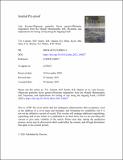Late Eocene-Oligocene granulite facies garnet-sillimanite migmatites from the Mogok Metamorphic belt, Myanmar, and implications for timing of slip along the Sagaing Fault
Abstract
The Mogok Metamorphic Belt (MMB) in Myanmar is a polymetamorphic, mainly Paleogene granulite-uppermost amphibolite facies terrane consisting mainly of marbles and calc-silicates hosting spinel, ruby and sapphire. Jurassic charnockite-syenite intrusions, as well as Eocene-Miocene leucogranite intrusions are also present. Pelitic rocks are uncommon, and where present, have sillimanite, both as primary inclusions in garnet and as secondary Bt + Sil coronas around garnet. Core samples from the Kyi-Tauk-Pauk gold mine at Thabeikkiyin, north of Mandalay, are mostly Grt + Bt + Sill gneisses and migmatites with uncommon interbanded Opx + Grt + Bt gneisses. Pseudosection modelling suggests prograde garnet growth occurred by biotite-dehydration melting that reached peak P–T conditions of 870–970 °C and ~ 0.9 GPa, and was followed by garnet breakdown forming coarse retrograde Bt + Sil coronas. U[sbnd]Pb monazite data show an early high-grade granulite event at 43–32 Ma, and a later upper amphibolite sillimanite-grade event peaking at 23–20 Ma, with a change in monazite chemistry after c. 22 Ma that is consistent with fluid/(melt) interaction and garnet breakdown. Elevated Th/U ratios from ~35 to 22 Ma, and at ~18 Ma are compatible with melt influx at that time, timing that is similar to the age of the regional Kabaing leucogranite in the Mogok valley area. Our data show that peak granulite facies metamorphism along the Mogok Metamorphic belt was mainly Middle Eocene-Early Oligocene, with upper amphibolite facies metamorphism extending to earliest Miocene. The MMB is cut abruptly by the Sagaing fault, a large-scale dextral fault that extends from the Andaman Sea north to the East Himalayan syntaxis. Our new U[sbnd]Pb monazite data constrain the oldest age of initiation of the eastern branch of the cross-cutting Sagaing dextral strike-slip fault at
Citation
Lamont , T N , Searle , M P , Hacker , B R , Htun , K , Htun , K M , Morley , C K , Waters , D J & White , R W 2021 , ' Late Eocene-Oligocene granulite facies garnet-sillimanite migmatites from the Mogok Metamorphic belt, Myanmar, and implications for timing of slip along the Sagaing Fault ' , Lithos , vol. 386-387 , 106027 . https://doi.org/10.1016/j.lithos.2021.106027
Publication
Lithos
Status
Peer reviewed
ISSN
0024-4937Type
Journal article
Description
MPS is grateful to the Oxford-Burma Aung San Suu Kyi trust for funding research and field visits to Mogok. U-Th-Pb geochronology was funded by UCSB and NSF grants EAR-1348003 and EAR-1551054 to BH.Collections
Items in the St Andrews Research Repository are protected by copyright, with all rights reserved, unless otherwise indicated.

